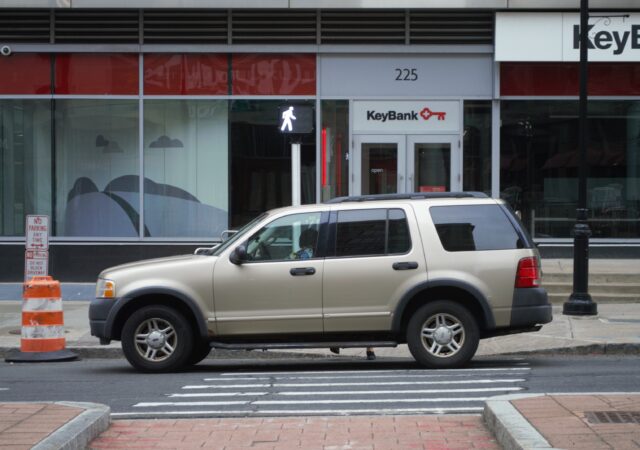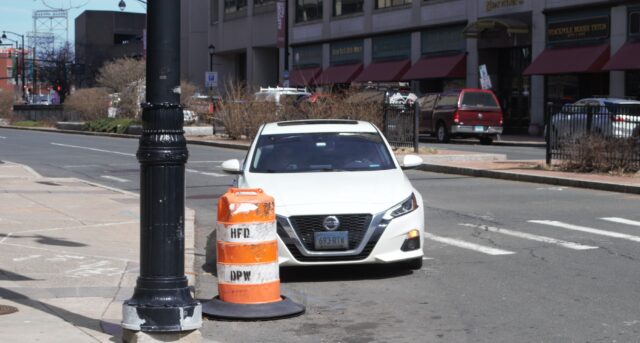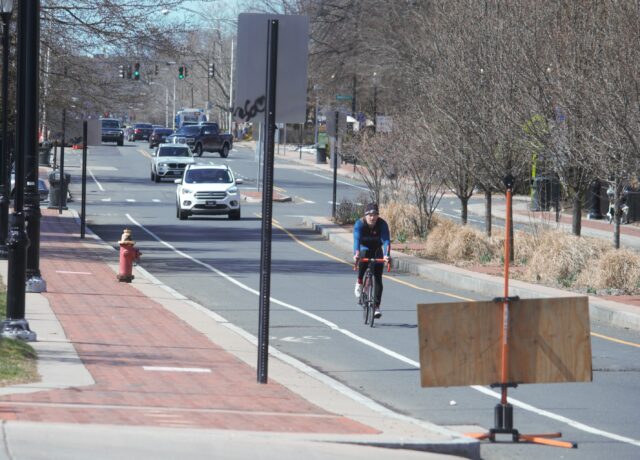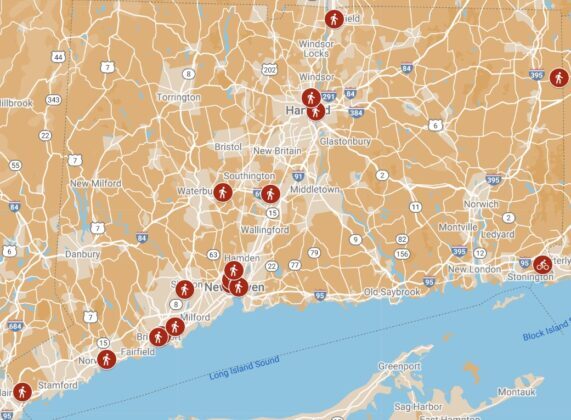The Town of Fairfield recently took to social media to give advice for how to “stay safe while sharing the road,” and did what so many do and have done for the last however many years: started off by telling bicyclists, then pedestrians, and then a mile into the post, drivers, how to behave. Ordering the advice in that way gives the impression that those who are most vulnerable have more responsibility than those who are operating tons of metal and plastic. The advice given is also flawed for numerous reasons specific to the town, but why I am mentioning this at all is because what they posted is commonly repeated and unhelpful: “For pedestrians, it’s important to use crosswalks when crossing the street. This allows motorists to anticipate pedestrian movement and reduces the risk of [crashes].”
Nevermind how the most natural human movement has been legally restricted to make way for the automobile, this is not life-saving advice. There is data showing that drivers still managed to hit and kill pedestrians in marked crosswalks in Connecticut. Last year, a driver killed two pedestrians using a crosswalk in Stamford. They were noted to have taken no improper action. They behaved predictably. The driver was clocked at 86 MPH. About 700 feet away on the same road, another motorist killed a pedestrian at an intersection in 2022.
The conclusion to reach is not that the pedestrians needed to be in the crosswalk. They were. They are still gone.

But that is not the only problem with that victim-blaming disguised as advice.
In reality where I live, crosswalks are often obstructed, and because I know this might come into question, I took photos of the same crosswalk in Hartford on two consecutive days. Not staged. Not me standing there waiting for someone to do the wrong thing. This involved me simply pulling out my camera while I was naturally on my way somewhere else.
The photo above shows that there is also a “No Parking” sign indicating what should be obvious to automobilists: the crosswalk is not a parking space. There was ample space behind the vehicle where the person could have stopped. There was plenty of parking on the other side of the road. But they were very busy and very important, and could not be bothered to walk more than ten steps to the bank’s ATM.
When I motioned that they were in the crosswalk and suggested they find another place, the passenger yelled insults at me that were audible all the way as I walked down the block. I wondered, to myself, how they were raised that they felt it was no big deal to needlessly put others in harm’s way.
There was no such interaction with the occupants of the car pictured below, but they did not move either.
In both cases, I knew that as I was crossing, should someone hit me, I would be the one blamed because I was not using the precious painted pedestrian zone, even though that had been closed to me.
While this does not impact me personally, it needs to be said that parking like this also blocks the curb ramp, which means someone has stranded people using wheelchairs and other mobility devices. The situation is much more dangerous for them because now they need to travel along the street until they find another ramp.

The same thing happens with unprotected bike lanes. The photo below was taken of Hartford’s Farmington Avenue. There was construction up the road and that cannot be helped, but there is no excuse I can find for why someone chose to place a large sign announcing the end of construction — in the bike lane.
Anyone operating a motor vehicle or a bicycle should be able to see that there is no longer machinery taking up half the road. The sign seems silly, but it’s likely legally required. The question is: why imperil someone on a bicycle to deliver this less essential information if the sign could be placed in the median? Could the sign be smaller and tucked into the sidewalk’s “furniture zone,” where it will not impede pedestrians or cyclists? Could the sign go in the car lane instead, like a buffer between that and the bike lane?
Cyclists are scolded to behave in ways that are predictable to drivers, yet what happens is that we advocate for bike lanes and get mere paint. We then have everything you can imagine blocking that tiny space — non-essential construction signs, drivers who say “it’s just for a minute” because their convenience is valued more than your safety, delivery trucks, debris from car crashes, bulky waste. That forces people riding bikes to ride them erratically.
I can explain this forever, but car brain will still have some people concluding that what pedestrians and cyclists need to do is use specific (often absent or unavailable) spaces while wearing hi-vis clothing.

In March, drivers killed five pedestrians and one cyclist in Connecticut.
The most recent death was of Kendall May, 56, on Hartford’s Main Street. The pedestrian’s legal choice for crossing this four-lane road with no median: an unmarked intersection or one that was marked but very faded. This happened where there are several restaurants, a popular social club, and bus stops; in other words, motorists should expect foot traffic.
It was said that the motorist was traveling at a high rate of speed. Well, no shit sherlock. Those with the power to change the road have not, and it remains a street where high speeds are easily achieved outside of rush hour. There have been eight fatal motor vehicle crashes on Main Street north of downtown since 2015; three of these have involved pedestrians. What amounts to one fatal crash per year over a couple miles of one road should be a red flag.
It’s the street design, stupid.
The vehicular violence for the month began in Westport when a driver killed Matthew Balga, 54, a chef at a nearby restaurant. The victim was crossing the road in an area where the report indicates lighting was unknown, which is an interesting way of saying that street lighting was likely inadequate. Area residents have told me that this area is treated as a speedway, despite seeming like a place that should be a slower, more walkable area.
Two days later, a driver killed Gary F. Piver, a day short of 70, while he was biking home from his job. His commute required him to use Route 1, which decision-makers have chosen, for years, not to upgrade with sidewalks and bike lanes. While different electeds are busy pointing fingers at each other, their inaction is resulting in deaths. The news loves them some “hit and run” reporting that focuses on whether or not the driver has been caught, but they would do well to tilt their heads and begin asking over and over what our government is doing to fix known problems, like no separate space — a sidewalk — that a person could have been using. Separated spaces do not prevent 100% of deaths, but when present and maintained, people use them. When roads are designed for motorists to go slower, most do.
Two days after that preventable death, a driver killed Jae’mar Dillard. The pedestrian was using 844, a state route in Waterbury where there are no sidewalks. At the intersection with Pierpont Road, there is no marked crosswalk, nor a pedestrian signal. The beg buttons exist merely to summon a green light. While there are numerous bus stops along this road, it is unclear how a person is expected to safely access them with an absence of infrastructure that might provide even minimal protection for pedestrians. The shoulder is narrow. Lighting appears to be poor. The speed limit in this area is 35 or 40. Signage is spotty. Dillard’s preventable death is as much on Waterbury and Connecticut as it is on the driver who struck him.
On March 9, 2023, two drivers killed two pedestrians.
The first was John Gursky, 67. He was the ninth person outside of a vehicle to be killed by one on Hamden’s Route 10 since December 2016. Car-centric street design has undoubtedly played a role in these deaths. A pedestrian was killed on the same block as Gursky in 2016. A driver killed a cyclist one block south in 2020; that motorist was traveling so fast that he broke two utility poles and flipped the vehicle. A few blocks south of there, also in 2020, a driver was going so fast that she killed two men who were waiting at a bus shelter.
Later that day, Donna Berry, 63, was killed while walking a dog. She was in a corner of Western Greenwich Civic Center Park. The driver left the road, killing her.
The conclusion to reach while thinking about these unnecessary losses is not that pedestrians should be in the crosswalk or wearing hi-vis or waving pathetic flags to cross the street. It’s something that does not involve scolding regular people for their behavior, but demands we hold accountable those in power who allow poorly designed streets, neglected infrastructure (broken street lights, faded crosswalks), and hold accountable both the automotive industry that does not install speed limiters or interlock ignition devices as the default. It demands we hold accountable those who protect that industry from making changes. This does not mean absolving reckless drivers, but refusing to look away at what has allowed so many of them to take the lives of others.
Then, when the majority of crashes have been prevented, feel free to go after individuals for making poor choices.

Greg Cantwell
Hi,
This comment is not related to this article, but I couldn’t figure out how to post a general comment. I enjoy your posts. Since moving to the city last year and taking some long walks, I’ve become focused on fountains in the city. They help liven the city up. Oddly, the fountain at the entrance to the MDC building on Main Street stays dry all year. It is made of the same granite as the MDC building, so it is theirs and not the condos. I know MDC has other issues going on, but it is ironic that our water authority can’t use it’s designed fountains. They’ve become large trash bins. Anyway, having them functioning would be nice. I emailed a couple MDC reps. No response.
Kerri Ana Provost
The cobbler’s children have no shoes.
It’s not their best advertisement for themselves, is it? But I guess you don’t need to when the utility is a monopoly.